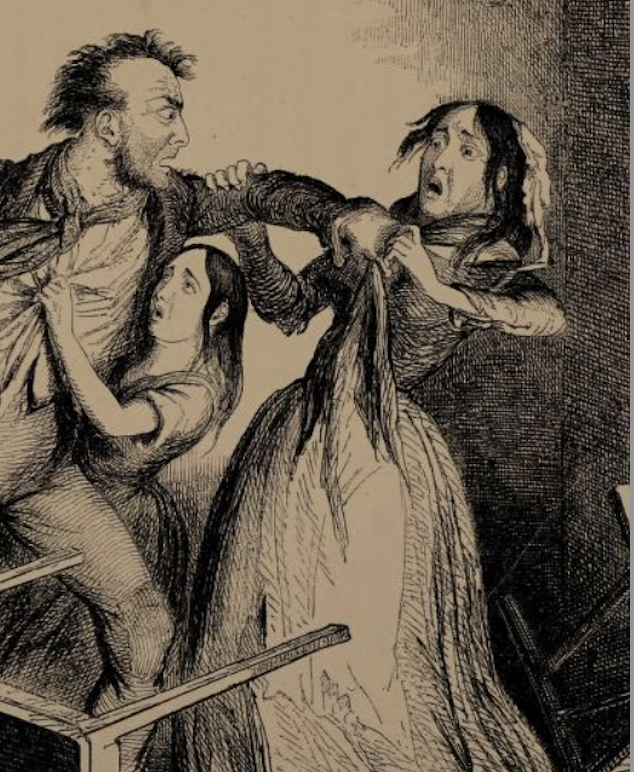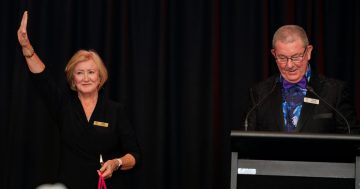
Fearful quarrels, one of eight etchings by British caricaturist George Cruikshank published in London in 1847. Photo: Supplied.
On Springhill Road, on the eponymous hill just to the north of BlueScope Steel and the big Colorbond sign, a lone giant fig tree still stands.
On this site in 1834 two assigned convict girls – Mary Maloney and Sarah McGregor – adopted a direct action approach to the treatment being meted out by their convict master Captain Charles Waldron.
Waldron had arrived in Sydney at the end of November 1831. He was accompanied by his wife and nine surviving children. And they soon came to Wollongong.
In December 1833, Mrs Jemima Waldron was in bed at Spring Hill nursing her newborn child. The next month two convicts from the Female Factory were assigned to the good captain and his wife.
Mary Maloney was 25 years old and Sarah McGregor was just 18.
McGregor was the smaller of the two and a news report described her as “feminine and amiable, with considerable personal attractions as to feature, though not to figure.”
Captain Waldron was 54 and, with his wife now preoccupied with her new-born child, he appears to have turned his attention to his recently assigned convict women.
Apparently unimpressed by the apparently randy old goat’s unwanted advances, Mary and Sarah decided to resist the next time the captain annoyed them.
Unfortunately, Captain Waldron seems to have proved to be one of those men who can resist anything except temptation.
Whatever precisely took place is difficult to know but, as it came out later in court, the girls quickly overpowered the good captain.
In the ensuing altercation, after much yelling and screaming, Captain Waldron stumbled and fell to the ground.
Roused by the disturbance Mrs Waldron came out on the verandah to see what the commotion was all about.
There she saw her husband with Mary Maloney being pulled off the top of him by a man then working as a carpenter on the Waldron’s Springhill Estate located to the west of what was back then a much larger Tom Thumb Lagoon than survives nearby today.
Mrs Waldron claimed in court that she then called out: “You vile and wretched and worst of women, what have you done to my husband?”
Mary Maloney, she claimed, then turned around and said, “You call me a wretch; do you know what a wretch is? And immediately pulled up her petticoats and exposed her person to me and my husband.”
Mary, it would appear, might have been trying to demonstrate to Mrs Waldron what her husband had been doing while she had been confined to bed after the birth of her child.
Francis Allman, the Wollongong police magistrate, later arrived at Springhill and found Captain Waldron in bed with his right side paralysed.
Allman noted that it was only with great difficulty that Captain Waldron could speak. It would appear that during his altercation with the women Waldron had suffered some sort of stroke. He died a fortnight later at Spring Hill.
Subsequently charged with murdering their master, both convict girls were thus in danger of being hanged.
While on trial in Sydney, Mary and Sarah were portrayed as having had adopted a rather scandalously joyous approach to their activities at Spring Hill.
Mrs Waldron’s evidence made much of the language used by the two women. Her claim was that it was “of the most disgraceful description”.
Captain Waldron’s widow also contended both women were equally violent and dangerous and that – after the incident – insisted upon being given all their clothes, as they now considered themselves free women, and so would not wait for the constable who had been sent for.
The jury of 12 men, however, took only half an hour to find both Sarah and Mary guilty of the murder of Charles Waldron.
Immediately, however, Sarah McGregor astutely “pleaded her belly”. It’s an elegant old legal phrase but, in short, it means Sarah claimed she was pregnant.
This clever move entitled her to a respite from being hanged until after her confinement. In practice a delay of up to nine months meant a death sentence was usually commuted to life imprisonment.
So the judge duly ordered a stay of execution and directed the sheriff to return a jury of 12 matrons “to inquire whether or not Sarah McGregor be quick with child”.
A week later the matrons were empanelled and, after examining Sarah for half an hour, returned a verdict of “not quick with child to the best of our opinion”.
Both Sarah and Mary were thus doomed to hang.
But a miracle happened.
A physician with a fine name – Dr Montague Grover – came forth with new evidence.
“I attended Captain Waldron from the day on which he was taken ill until the day before his death,” Dr Grover reported.
“After the assault I examined his head very carefully but could discover no mark of violence whatever. After his death I called at the house and asked permission to open his head, which was refused by Mrs Waldron. This I very much regret as an examination would have thrown a great deal of light on the subject.
“He [Captain Waldron] had been in a declining state for some months … and I am decidedly of the opinion that there was a predisposition to paralysis. To me it appears highly probable that his decease arose from natural causes. The absence of all marks of violence goes a great way with me in forming this opinion.
“I think I may state with confidence that the blows he received after his fall could have had no effect. Before I conclude I think it right to add that Captain Waldron was very irritable and to my knowledge gave way to violent gusts of passion on very trifling occasions.”
So, despite what at least one historian once erroneously claimed, neither Mary nor Sarah were hanged and there survives a small but incomplete paper trail of the later colonial careers of these two pioneering Australian feminists.












